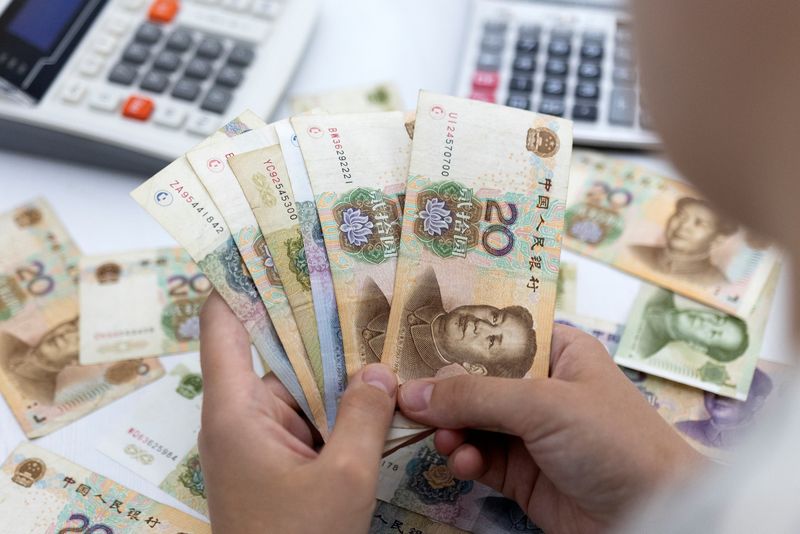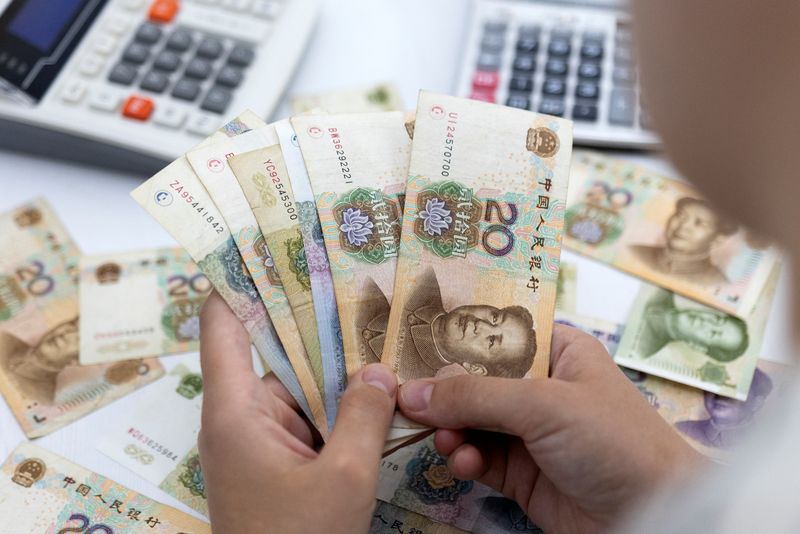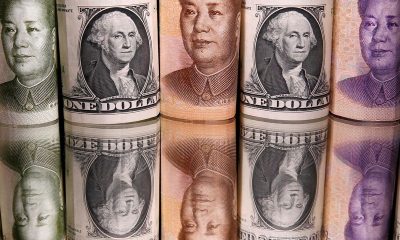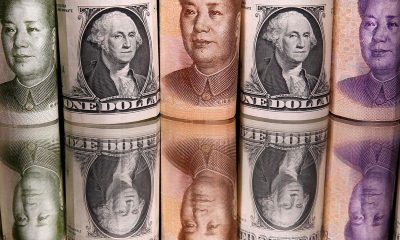Forex
How China talked markets out of a run on the yuan


© Reuters. FILE PHOTO: Woman holds Chinese Yuan banknotes in this illustration taken May 30, 2022. REUTERS/Dado Ruvic/Illustration/File Photo
SINGAPORE (Reuters) -In recent months, China has sought to stabilise the yuan by orchestrating buying by state banks and giving market guidance to bankers.
The strategy of moral suasion marks a sharp break from Beijing’s approach the last time the currency was on the ropes, in 2015.
Back then, the People’s Bank of China (PBOC) resorted to official intervention as the central bank burned $1 trillion in reserves to shore it up.
This year, as China’s economy wobbled and money left the country, the PBOC took a starkly different approach, defending the currency by signalling to markets what kind of selling it would and would not tolerate.
Interviews with 28 market participants show at least two dozen cases where regulators closely and frequently steered market participants through a range of co-ordinated actions this year to resist strong downward pressure on the yuan.
The PBOC and State Administration of Foreign Exchange, the currency regulator, did not respond to Reuters’ faxed questions about its approach. PBOC governor Pan Gongsheng has previously said regulators would prevent exchange rate overshooting risks and maintain stable FX market operations.
The strategy market participants and analysts described to Reuters has prevented a destabilising yuan slide.
However, they told Reuters that it has also chilled large parts of China’s foreign exchange market, crashing trading volumes and raising questions about the yuan’s chances of becoming a global reserve currency.
“The circumstances … at the moment are considerably more complicated because there are both domestic as well as global macroeconomic factors,” said Eswar Prasad, Tolani senior professor of international trade policy at Cornell University.
He described the PBOC’s use of “non-standard measures to intervene in foreign exchange markets” as a form of “triage” to stop the yuan falling too rapidly.
As the currency of the world’s second-largest economy and biggest exporter, the yuan’s value determines the price of goods around the world and trillions of dollars in capital flows. It also serves as a barometer of China’s challenges.
A Chinese forex regulator, speaking on condition of anonymity, said the currency’s value was ultimately determined by fundamentals and currently a product of how “effectively China can thwart decoupling”, a reference to Western efforts to reduce economic reliance on China.
Ten traders interviewed by Reuters said key warnings first emerged in June when the PBOC’s daily yuan guidance that determines its trading range for the day, known as the midpoint, started to diverge from market expectations.
In theory, the midpoint is based on contributions from 14 banks and referenced to the previous day’s trade and overnight moves, which should make it easy for markets to predict.
By August, however, the midpoint’s yawning deviation from trader estimates was read by the traders interviewed by Reuters as a signal the PBOC did not want the currency to go where markets were pushing it.
AGAINST THE TIDE
Managing a currency can be a white-knuckle ride. In 2015, China cut the yuan’s midpoint by 2%, with the PBOC saying it was a one-off move to bring the trading band in line with market pricing. Fearing further devaluations, however, investors sold Chinese assets, sending stocks and the yuan into freefall and forcing the bank to use reserves to stabilise the currency. This time, efforts to manage the yuan involved more targeted and specific directions to banks and currency market participants, according to the traders who spoke to Reuters.
For example, whenever momentum seemed against the yuan, state-owned banks quietly became buyers, the traders said. This generally happened around psychologically significant currency levels and seemed aimed at containing volatility. Those traders told Reuters that in late May they noticed state banks stepping in with two days of yuan buying after the currency hit its lowest then for 2023.
Similarly, state banks’ yuan buying intensified in December after Moody’s announced a cut in China’s ratings outlook. Individual traders were not able to estimate the size of buying nor was Reuters able to confirm whether such trading was directed by the central bank.
Official data shows no evidence the PBOC sold dollars outright as it did in 2015. However, market participants noted banks sold dollars acquired by currency swaps, which would not be seen in such data.
At the same time, smaller lenders have experienced increased “window guidance” or unofficial, verbal advice from regulators to have both banks and their clients reduce dollar holdings, according to six trader and banking sources.
In June and July, the China FX Market Self-Regulatory Framework, which is overseen by the PBOC, told major state-owned banks to cut dollar deposit rates, which would encourage exporters and households to switch dollar receipts into yuan, market watchers said.
WORKING THE PHONES The pressure on bankers has mirrored pressure on the yuan, which is down almost 2.8% against the dollar this year even though the benchmark lost 2.2%.
On Sept. 8, the yuan struck a 16-year low. A few days later, managers at eight major banks were summoned to Beijing to meet PBOC officials, according to five banking sources, two of whom attended the meeting. They were told companies wishing to buy more than $50 million would need approval from the PBOC, three sources said. Bankers were also told they needed to cut spot trading, stagger dollar buying and not hold net long dollar positions at the end of any trading day, two sources said.
Authorities also focused on monitoring exporters’ foreign exchange buying and selling plans given their large currency holdings and outsized sway on yuan moves.
In recent months, regulators have called banks and queried them with surveys on a near weekly basis on the intentions of exporter customers, according to officials at five banks who spoke to Reuters. Such calls had previously been sporadic and surveys sent only monthly.
The volume of yuan traded onshore slumped 73% from August’s level to a record low of 1.85 trillion yuan in October. That shows China’s bankers have heeded the call to reduce trading, particularly dollar buying, but also that the central bank’s efforts are chilling the market, analysts say.For now, however, the currency appears to have stabilised comfortably above September’s 16-year low.
Market players are unwilling to directly fight the PBOC — but nor are they willing to acquiesce entirely.
“I’ve been closely monitoring dollar prices this year, as I have dollar payments coming in every few weeks,” said one Shanghai-based exporter of electronic components surnamed Zhu. “The daily question has been: ‘Do I need to save them, or convert them back into yuan?'” So far, she has saved them on expectations of a better yuan price for her dollars.

 Forex3 years ago
Forex3 years agoForex Today: the dollar is gaining strength amid gloomy sentiment at the start of the Fed’s week

 Forex3 years ago
Forex3 years agoUnbiased review of Pocket Option broker

 Forex3 years ago
Forex3 years agoDollar to pound sterling exchange rate today: Pound plummeted to its lowest since 1985

 Forex3 years ago
Forex3 years agoHow is the Australian dollar doing today?

 Cryptocurrency3 years ago
Cryptocurrency3 years agoWhat happened in the crypto market – current events today

 World3 years ago
World3 years agoWhy are modern video games an art form?

 Commodities3 years ago
Commodities3 years agoCopper continues to fall in price on expectations of lower demand in China

 Economy3 years ago
Economy3 years agoCrude oil tankers double in price due to EU anti-Russian sanctions


























